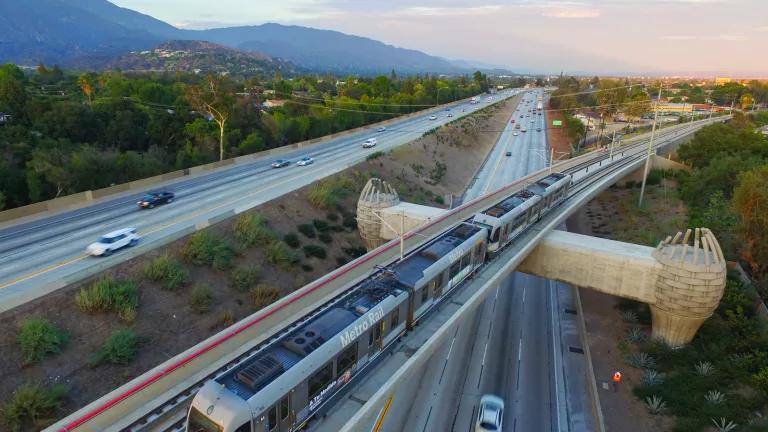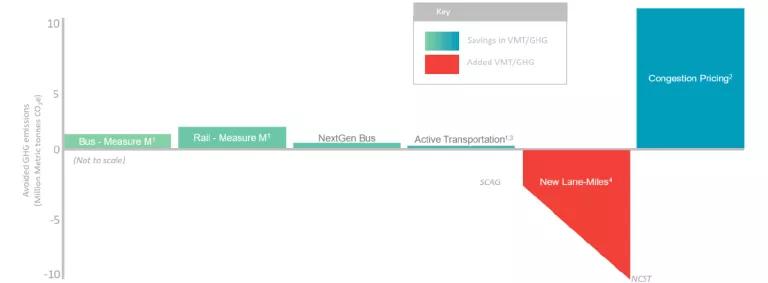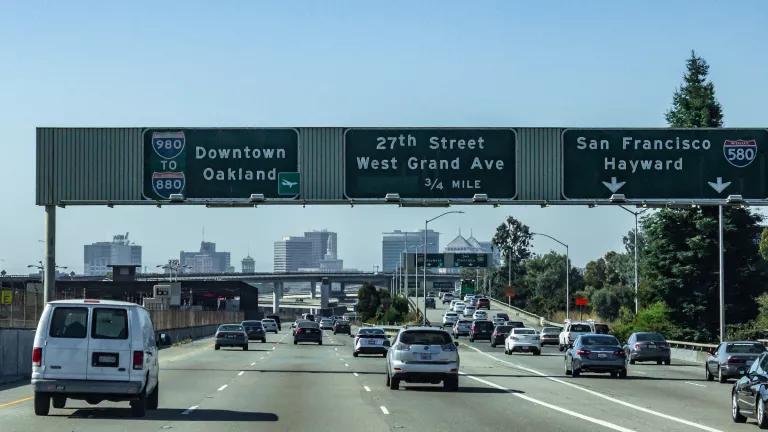Los Angeles Freeways Are a Climate Dead End
NRDC believes that Metro must stop highway expansions to protect both the climate and the health of Angelenos.

While people think of Metro first for its expansive rail and bus systems, Metro is more than a transit provider. The $8 billion-a-year agency touches almost every aspect of transportation in LA County. With such wide-ranging operations, Metro’s decisions have a huge impact on how Angelenos get around - and how much pollution they generate doing so. A new analysis conducted by Metro shows that the agency can reduce greenhouse gas emissions by tens of millions of metric tons in the coming decade by investing in sustainable mobility, but that continuing to pour money into highway expansions will negate much of that savings. NRDC believes that Metro must stop highway expansions to protect both the climate and the health of Angelenos.

Relative Change in GHG Emissions Resulting from Metro’s Initiatives, 2017-1047 (Million Metric tons CO2e)
Metro’s Analysis
Metro’s last major attempt to evaluate its climate impact came as part of the 2020 Long Range Transportation Plan. The plan looked at the entirety of Metro’s operations, which obscured the difference between programs that are good for the climate and programs that are not. In contrast, this analysis disaggregates Metro’s planned investments into five broad categories: transit infrastructure expansion, improved bus service, active transportation, road construction, and congestion pricing. The study team estimated each category’s effects on vehicle-miles traveled (VMT), then translated these estimates into greenhouse gas emissions estimates using a methodology from the California Air Resources Board.
Looking at the results of Metro’s analysis, it is clear that the highway program is out of line with the rest of the agency’s work. Depending on how you estimate the VMT induced by road construction, this work could completely outweigh the benefits of Metro’s transit and active transportation investments. Exactly how the balance looks is based on how you choose to estimate the effects of road construction. Metro has chosen to provide a range of estimates, with the lower number being based on a methodology from the Southern California Association of Governments and the higher number being based on the University of California Davis Induced Travel Demand Calculator. While we appreciate Metro’s transparency here, we believe that the agency should be using this higher figure. The Induced Travel Demand Calculator is used by Caltrans as its default tool for VMT modeling and is the basis for NRDC’s own SHIFT calculator.
By far the biggest VMT reductions in this analysis come from congestion pricing. Metro estimates that its proposed congestion pricing program could reduce VMT enough to make up for even the highest estimate of VMT induced by building more roads. However, this program is still early in development and congestion pricing is not currently permitted under state law. Congestion pricing has huge potential to decrease emissions in LA, but we cannot count on hypothetical congestion pricing to balance out very real highway expansions.
Effects on Surrounding Communities
The issue of what projects Metro pursues is not just about climate. Highway construction harms our communities, can displace people from their homes, and poisons the air. Los Angeles hacked its highways through Black and brown communities, and to this day activists are fighting (and winning!) against projects - such as the 710 expansion - that would displace hundreds more households. People who keep their homes but have to live near highways face dramatic health risks. 1.2 million Southern Californians live within 500 feet of a highway, a public health crisis that leads to elevated rates of asthma, cancer, and other diseases. The health impacts are even greater for people, especially children, living along freight corridors with significant truck traffic that exposes them to high levels of toxic diesel exhaust.
Given the impacts on health, displacement, and the environment, Metro must not continue down its current path. Stopping highway expansions would be a health and sustainability win for the county in its own right and would also mean more money for community-centered transportation projects that reduce pollution, improve health, and help Angelenos get around. For example, Metro’s fiscal year 2022 budget includes nearly $300 million dollars for highway expansions compared to the $73 million Metro collects in fare revenue. If the agency repurposed the money set aside for highway expansions it could completely eliminate fares while having more than $200 million left over to co-develop programs with directly impacted communities.
What’s Next?
Metro’s own analysis - which we commend them for performing - shows that the agency needs to reassess its priorities. The agency’s Vision 2028 strategic plan states that “Metro shares the region’s commitment to environmental sustainability and will take a strong leadership role in managing and building a resilient mobility system that effectively reduces greenhouse gas emissions and helps to address public health issues while moving people throughout the County.” Despite this, the agency is spending hundreds of millions of dollars each year on highway expansions that increase emissions and harm public health.
This money spent on highways is bad for the climate and bad for Angelenos. The agency should follow through on the commitment set in its Equity Platform and work in partnership with directly impacted communities to chart a new path that increases sustainability and public health and repairs the damage highways have already caused. Los Angeles - and the planet - deserve better.




